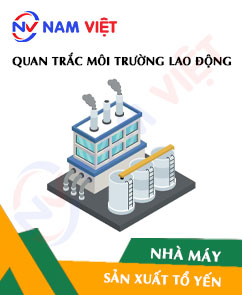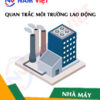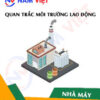Occupational environment monitoring at a bird’s nest manufacturing factory
99,000 ₫
Note: The above price is calculated for one sample, and the price may fluctuate depending on the area of the environment to be monitored and market movements. For more accurate pricing support, please refer to the price list or contact our consulting staff directly.
Monitoring the environment of a bird’s nest production factory is a session of collecting, analyzing, and evaluating workplace factors that may be harmful to workers health.
Table of Contents
Toggle1. Overview of the Bird’s Nest Manufacturing Factory
a. What is a bird’s nest manufacturing factory?
Factory producing bird’s nests is an industrial facility designed for the production and processing of bird’s nests. A bird’s nest is a type built by swiftlets using their saliva, considered a precious ingredient in traditional cuisine and medicine.
In a bird’s nest manufacturing factory, the main process includes collecting bird’s nests from nest stalls or swiftlet farms, then processing and cleaning them before packaging and exporting. The processing stage may include separating nests from foreign materials such as leaves or dirt, cleaning the nests, and drying them to remove moisture. Then, the bird’s nests are packaged according to different standards and requirements to meet market demand.
Bird’s nest manufacturing factories are usually equipped with modern equipment and technology to ensure product quality and safety. Hygiene standards and quality control procedures are also applied to ensure that bird’s nests are produced and processed correctly and achieve high quality.

b. Production stages in a bird’s nest manufacturing factory
Production stages in a bird’s nest manufacturing factory may include the following steps:
- Collecting bird’s nests: This involves collecting nests from nest stalls or swiftlet farms. Bird’s nests may be collected manually or using automated methods.
- Removing foreign materials: Nests may contain foreign materials such as leaves, dirt, or other hard substances. This step involves separating the nests from these materials using devices such as sieves or manually.
- Cleaning: After separation, the nests need to be cleaned to remove impurities such as feathers, dirt, and other contaminants. Cleaning may be done using water or special cleaning solutions.
- Drying: After cleaning, the nests need to be dried to remove moisture. Drying can be done naturally or using industrial dryers.
- Sorting and grading: Dried nests are sorted and graded according to different standards. Factors such as size, color, quality, and origin may be used to classify the nests.
- Packaging and exporting: Finally, bird’s nests are packaged according to different standards and requirements. Packaging may use specialized materials to protect the nests and maintain quality during transport and export.

c. Machinery used in a bird’s nest manufacturing factory
In a bird’s nest factory, various machinery and equipment may be used to support production stages. Common machines include:
- Bird’s nest collection machines: Special machines and equipment can be used to collect nests from stalls or farms, including chute systems or automated collection devices for efficiency.
- Nest separation machines: To remove foreign materials such as leaves, dirt, or other hard substances, sieving machines or specialized separation devices can be used. Sieving machines help separate nests by size or remove larger contaminants.
- Nest washing machines: Cleaning nests can involve washing machines or automatic nest cleaning systems, using water or cleaning solutions to remove feathers, dirt, and other impurities.
- Drying machines: Industrial dryers or natural drying systems can be used to remove moisture from cleaned nests. Industrial dryers use controlled temperature and airflow for efficient drying.
- Sorting and grading machines: After drying, nests can be sorted manually or with automatic grading machines. These machines classify nests based on size, color, and quality accurately.

d. Occupational diseases for workers in a bird’s nest factory
Workers in a bird’s nest manufacturing factory may suffer from several occupational diseases related to processing bird’s nests. Common occupational diseases include:
- Hyperhidrosis and skin infections: Due to a humid and high-temperature environment, workers may develop conditions caused by fungi and bacteria.
- Respiratory diseases: Workers exposed to nest dust may be affected by respiratory conditions such as pneumonia, sinusitis, rhinitis, and colds caused by bacteria or nest dust particles.
- Allergies: Frequent contact with nests can cause skin allergies, rhinitis, coughing, itching, and other allergic symptoms in some individuals.
- Hand-foot-mouth disease: During processing, workers may come into contact with chemicals or bacteria leading to infections such as hand-foot-mouth disease.
- Injuries: Factory environments pose risks such as falls, slips, and collisions with equipment and machinery.
To reduce the risk of occupational diseases, bird’s nest factories must implement occupational safety measures and environmental management to ensure a healthy and safe working environment. Workers should also be trained in preventive measures and properly use personal protective equipment when necessary.

e. Common types of bird’s nests on the market
There are many types of bird’s nests on the market, classified by origin, quality, and processing method. Common types include:
- Wild bird’s nests: Formed naturally by wild or naturally raised swiftlets. Considered premium with high value.
- Farmed bird’s nests: Produced by swiftlets in farms. These nests are usually more uniform and controlled during care and processing.
- Special bird’s nests: High-quality, carefully selected nests, such as large-sized, uniquely shaped, special-colored nests, or those found in unique locations like caves.
- Threaded bird’s nests: Have longer, softer fibers and are used in traditional bird’s nest dishes.
- Dried bird’s nests: Dried to remove moisture, easier for storage and transport than fresh nests.
- Processed bird’s nest products: Include products such as bird’s nest drink, bird’s nest cake, bird’s nest milk, and other bird’s nest products.
2. Overview of occupational environment monitoring services
a. What is occupational environment monitoring in a bird’s nest factory?
Occupational environment monitoring (or labor environment assessment) in a bird’s nest factory involves collecting, evaluating, and analyzing measurement indicators of workplace environmental factors to promptly apply measures to minimize environmental hazards, protect workers’ health, and prevent occupational diseases. This monitoring is mandatory for bird’s nest factories.
Occupational environment monitoring plays a critical role in caring for, protecting, and enhancing workers’ health, as the workforce is the main resource directly generating profit for the company. Workers regularly exposed to hazards beyond allowable limits may suffer health issues and occupational diseases.
REGISTER FOR OCCUPATIONAL ENVIRONMENT MONITORING SERVICE
b. Nam Viet’s occupational environment monitoring program
Nam Viet’s occupational environment monitoring program is developed by engineers specializing in labor safety and environmental protection. Aiming to ensure workers’ health and safety, the program uses modern measurement methods to monitor air, water, microclimate, physical factors, dust, and other workplace environmental elements. It is essential for maintaining a safe work environment and protecting workers’ health.
Additionally, Nam Viet’s program plays a key role in researching and developing new solutions to improve labor environmental quality. With the dedication and professionalism of the monitoring experts, Nam Viet’s exclusive program represents a breakthrough in occupational safety and environmental management in Vietnam.

c. Standardization in occupational environment measurement procedures
Standardization in Nam Viet’s measurement procedures is crucial for ensuring the accuracy and reliability of results. The program follows recognized standards and standardized procedures from the Ho Chi Minh City Department of Health. This ensures that collected data is highly reliable for evaluating workplace conditions and making decisions to improve worker health and safety.
These standardized procedures also ensure that measurements are conducted by highly qualified monitoring specialists with years of experience, allowing managers and experts to trust the results and make accurate, valuable decisions in protecting worker health and the environment.
By applying standardized procedures, Nam Viet demonstrates its commitment to ensuring a safe workplace and protecting worker health while contributing positively to the advancement of occupational safety and environmental management in Vietnam.
d. Occupational environment monitoring report for a bird’s nest factory
Monitoring results are compiled according to Form 04, Appendix III, issued with Decree 44/2016/ND-CP and prepared in two copies: one sent to the contracting workplace and one retained by the monitoring organization.
Monitoring records must be kept indefinitely according to legal regulations.

e. Frequency of occupational environment monitoring according to law
According to Clause 2, Article 18 of the Labor Safety and Hygiene Law 84/2015/QH13, employers must organize workplace monitoring to assess harmful factors at least once a year.
f. Deadline for submitting occupational environment monitoring reports according to law
Reports must be submitted before December 31 each year. Enterprises of production facilities are required to submit monitoring results to the local Department of Health where the facility is headquartered and where workers are employed.
When there are changes in technology, production processes, or upgrades to facilities that may introduce new harmful factors to worker health, enterprises must update labor hygiene records regarding factors requiring monitoring.
g. Penalties for employers violating occupational environment monitoring regulations
According to Article 27 of Decree 12/2022/ND-CP dated January 17, 2022, on administrative penalties in labor, social insurance, and Vietnamese workers working abroad under contracts:
- Clause 2: Fines from VND 2,000,000 – 5,000,000 for employers failing to publicly inform workers at monitored sites and evaluated workplaces immediately after obtaining monitoring results and evaluations.
- Clause 3: Fines from VND 20,000,000 – 40,000,000 for employers who do not conduct occupational environment monitoring to control hazards to worker health as required by law.
- Clause 4: Fines from VND 40,000,000 – 60,000,000 for employers collaborating with monitoring organizations to commit fraud in monitoring activities without reaching the level of criminal liability.
3. Environmental Factors Harmful to Workers in Bird’s Nest Production Factories
Workers in bird’s nest production factories may be exposed to several harmful environmental factors. Below are some potential environmental factors that could affect workers’ health:
- Bird’s nest dust: The processing of bird’s nests may generate dust, especially when nests are dried or ground. Bird’s nest dust can irritate the respiratory system, causing coughing, difficulty breathing, and pneumonia.
- Chemicals: During bird’s nest production, processing agents, cleaning chemicals, and preservatives may be used. Long-term exposure to these chemicals can cause skin irritation, allergies, and affect the nervous system.
- Humid environment: Since bird’s nests require a humid environment for development, factories often have humid working conditions. Humidity can promote the growth of bacteria, fungi, and infectious agents.
- Biotoxins: In some cases, bird’s nests may be contaminated with bacteria or other harmful substances. Workers exposed to contaminated nests may face infection risks and related health problems.
- Safety hazards: Bird’s nest production factories may have equipment and machinery operating in humid conditions. This creates risks of slipping, falling, collisions, or other accidents, especially if occupational safety rules are not followed.
REGISTER FOR WORKPLACE ENVIRONMENT MONITORING SERVICE
4. Measures to Improve Working Conditions in Bird’s Nest Production Factories
To improve working conditions in bird’s nest production factories and protect workers’ health, the following measures can be applied:
- Ventilation and fans: Ensure an effective ventilation system to provide fresh air circulation within the factory. Use fans and dust extraction systems to remove bird’s nest dust and maintain clean air.
- Maintain hygiene and cleanliness: Keep the workplace clean through regular sanitation and cleaning of work areas. This helps prevent the growth of bacteria, fungi, and harmful insects.
- Use personal protective equipment (PPE): Ensure workers are provided with and properly use PPE such as masks, gloves, safety goggles, and dust-resistant clothing to protect against bird’s nest dust, chemicals, and other harmful elements.
- Training and education: Provide comprehensive training on occupational safety, health, and industrial hygiene. Ensure workers understand and follow safety rules, use PPE correctly, and know how to respond in emergencies.
- Equipment inspection and maintenance: Regularly inspect and maintain machinery and equipment to ensure safe and efficient operation. This includes ventilation systems, fans, bird’s nest processing equipment, and other safety devices.
- Periodic health checks: Conduct regular health check-ups for workers to detect health issues early and apply timely preventive and treatment measures.
- Periodically conduct workplace environment monitoring in the factory, collecting and analyzing harmful factors to workers, and then adjust to reduce risks to prevent occupational diseases.
5. Benefits of Periodic Monitoring in Bird’s Nest Production Factories
An Toan Nam Viet provides businesses with excellent benefits when using workplace environment monitoring services according to Decree 44/2016/ND – CP on management and control of harmful factors in the working environment affecting employees.
- Businesses can proactively control harmful factors in workshops or factories.
- Receive advice and recommendations on measures to minimize harmful factors and improve working environment quality.
- Indirectly protect human resources, the main factor in business development.
- Reduce the impact of occupational diseases on human health, thereby minimizing future treatment costs.
- Improving workers’ health leads to assured and maintained product quality and output.
- Comply with occupational safety laws, avoiding legal risks.
- Create credibility and professionalism in all aspects, enhancing the company’s brand reputation.
Nam Viet’s environmental monitoring service is a solution to minimize the impact of occupational diseases, contributing to a clean and high-quality working environment.

6. National Workplace Environment Monitoring Center
Workplace Environment Monitoring Center of Nam Viet is a professional unit specializing in monitoring and measuring workplace environmental quality across all provinces in Vietnam. With an experienced team of monitoring specialists, the center uses modern measuring equipment to ensure accuracy and reliability.
In addition to providing monitoring services, the center supports clients in planning, handling, and tracking workplace environment issues. With the motto “customer-centered,” the center prioritizes client satisfaction, meets all client needs, and commits to providing the best solutions for businesses.
REGISTER FOR WORKPLACE ENVIRONMENT MONITORING SERVICE
With investments in technology, equipment, and human resources, Nam Viet’s monitoring center has become one of the most reputable units in workplace environment monitoring in Ho Chi Minh City with the following objectives:
- We always value our brand reputation and the quality of our services.
- We provide clients with the best and most suitable solutions possible.
- With a team of experienced Masters and Engineers, aiming to protect the environment and benefit businesses.
- With Nam Viet Environmental Monitoring, companies receive professional service from experts in the field and the best cost incentives.
The workplace environment monitoring process at Nam Viet includes the following basic steps:
- Before conducting monitoring, our company ensures that all machinery and equipment are calibrated according to legal regulations.
- Strictly follow the committed monitoring procedures with the Department of Health.
- Report monitoring results honestly to employers.
- If monitoring results indicate unsafe conditions for workers, Nam Viet will support remediation solutions, and the enterprise shall:
- Implement measures to improve working conditions to minimize harmful factor impacts and prevent occupational diseases.
- Organize health check-ups to detect occupational and work-related diseases early for workers in unsafe positions.
- Provide in-kind compensation to workers according to labor law regulations.

7. Workplace Environment Monitoring Price List
To help businesses conduct professional and effective workplace environment monitoring, Nam Viet provides clients with a price list of workplace environment monitoring services with quality and reasonable costs.
- Our price list provides detailed information about the costs of monitoring services we offer, including transportation, measurement, analysis, and reporting. Clients can be fully assured of the accuracy and reliability of our monitoring reports.
- We commit to offering the most competitive and reasonable prices in the market, while being ready to quickly and professionally answer any questions about monitoring services.
- With Nam Viet’s monitoring price list, clients can easily choose service packages suitable for their needs. We guarantee maximum client satisfaction with professional service quality.
No comments yet












Review Occupational environment monitoring at a bird’s nest manufacturing factory
There are no reviews yet.